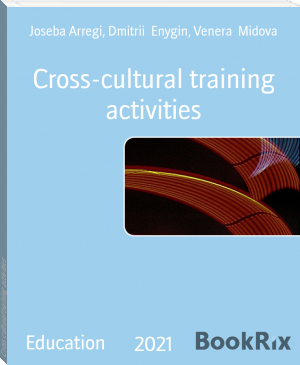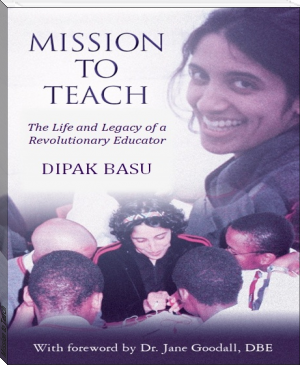Theories of intercultural education, Joseba Arregi, Asier Barandiaran, Dmitrii Enygin, Venera Midova [7 ebook reader .TXT] 📗

Book online «Theories of intercultural education, Joseba Arregi, Asier Barandiaran, Dmitrii Enygin, Venera Midova [7 ebook reader .TXT] 📗». Author Joseba Arregi, Asier Barandiaran, Dmitrii Enygin, Venera Midova
Teachers, especially those who teach second languages, had become aware of the need not only to inform on other “cultures and civilisations”, but to educate in students the capacity to ‘decentre’ oneself from one’s culture and to deal with ethnic, social and cultural differences. Some teachers were already intuitively drawing from their own personal experiences with the ‘target culture’ or the second language culture, experiences which they willingly shared with students, in order to provide them with an inside view. But going from teaching about cultures to developing intercultural competence was a complex task for teachers. For developing intercultural competence in students involves a shift from the information based approach to an approach based on mastering cultural analysis and cultural communication, which allow learners to interact successfully with people of other cultures and identities.
2.1 What is intercultural competence?
Intercultural competence has to do with the capacity to understand more than what the words record in spoken or written language. It has to do with the human communication process and therefore goes beyond linguistic competence. “The intercultural dimension is concerned with - helping learners to understand how intercultural interaction takes place, - how social identities are part of all interaction, - how their perceptions of other people and others people's perceptions of them influence the success of communication - how they can find out for themselves more about the people with whom they are communicating. » (Byram & alii, 2002, p.15) Teachers need therefore to help students develop “skills in understanding”, “skills of discovery and interaction” and behaviours expressing feelings, tolerance, respect, empathy and flexibility.
eLearning Papers • www.elearningpapers.eu • 2 No 7 • February 2008 • ISSN 1887-1542
People have different identities through which they participate in social interactions. Some persons are much more receptive to the different behaviours that generate these interactions. Intercultural competence can therefore be understood as someone’s “ability to ensure a shared understanding by people of different social identities”, and his or her “ability to interact with people as complex human beings with multiple identities and their own individuality”. (Byram & alii, 2002, p.10) It is therefore the opposite of trying to figure out cultural reactions by resorting to stereotyped information. For teachers it implies developing “learners as intercultural speakers or mediators who are able to engage with complexity and multiple identities and to avoid the stereotyping which accompanies perceiving someone through a single identity.” (Byram & allii, 2002, P. 9)
Teachers were used to ensuring students acquired a “working knowledge of the target culture”. They now need to go much further in helping students understand differences and otherness, explicit and implicit frames of reference, attitudes, beliefs and values and also students’ own self-awareness, the consciousness of their own culture, and their openness to differences, tolerance and mutual respect.
2.2 Assets of elearning for intercultural education:
Not only is intercultural competence a demanding programme, but teachers are also expected to come up with innovative pedagogical methods to reach students. As experienced for several years now, digital technology can offer real advantages for the ambitious learning goals that developing intercultural competence in students implies.
Learning is a global concept that refers, “in its broad sense, to a dynamic purposeful socio- psychological process of change in individuals and collectivities.” (Literature review and discussion, 2006, FeConE Consortium). As compared to other types of learning, there is a specific dimension that needs to be present in all school learning experiences and that is the thinking experience, for the one type of learning that schools need to excel in is “learning how to think”. It is in that sense that school or academic learning is always ultimately knowledge-based learning. It is about learning how to think with existing information and knowledge, learning how to think about things, about people, situations, events, nature, history, etc., in order to produce new information and now knowledge. And this is initiated by acquiring the specific language of each discipline, and the ‘way of thinking’ of that discipline. Diana Laurillard (1993) speaks of “articulated knowledge”, or “second-order experience of the world” obtained “through reflection on experience”.
Elearning in schools and universities is therefore knowledge-based learning integrating the use of digital technology in setting up learning environments. An elearning environment is one where the educational practices are partly or totally based on information and communication technology. There can be a combination of presential and distance learning, online and offline, solitary and group learning. But here also what is specific of academic elearning, as compared to other types of elearning is the central role of knowledge as the means for understanding in depth the significance of whatever is studied.
2.3 Providing a rich environment
One of the main difficulties of knowledge-based learning is providing the rich environment that will stimulate meaningful interaction between the information presented and the learning goals of the student. And this gap is largely filled by the enhanced learning experiences that elearning allows with multimedia presentations, graphical illustrations, live news reporting or coverage of news events, detailed photographic representations, etc. Multimedia presentations, live action and imagery provide socio-cultural contextual information, allowing learners to make relevant inferences, to cross visual and auditory information, and to construct meaningful interpretations of cultural phenomena.
eLearning Papers • www.elearningpapers.eu • 3 No 7 • February 2008 • ISSN 1887-1542
Besides multimodal representations, elearning environments integrate interactivity as the main mode of action for students. These systems are based on a learning concept where the learner is active, learning being interpreted as understanding, and understanding as doing and solving problems: learning is primarily a transformation process rather than a memory process. As the learner interacts with a training program, he is more involved and more active than if he was listening to a lecture. However this interactivity must not confounded with interaction. Interaction, which is a characteristic of human relationships, implies that when a person acts, he or she will be attentive to the response of the other person, expects the other person to do the same, and looks for the ensuing answer. This involves much more than the interactivity that machines are capable of. Still, many teachers, when resorting to an interactive approach to knowledge building, assume that the student is active and in interacting with the machine he or she will construct his or her knowledge. In language learning, the use of aural feedback can be a tremendous help in improving the mastery of speaking and listening to a language.
A further step becomes possible with elearning by creating a virtual immersion in the foreign cultural context. As stated in the Council of Europe’s “Practical Introduction” for language teachers” to develop the intercultural dimension, “The issues which need to be given priority are not the acquisition of more knowledge about a country or countries, but how to organise the classroom and classroom processes to enable learners to develop new attitudes (savoir être), new skills (savoir apprendre/faire and savoir comprendre) and new critical awareness (savoir s'engager). » (Byram & alii. 2002). Several reviews of projects, policies and frameworks focused on integrating ICT in classrooms have brought out that the rationale for using these digital environments invariably points to providing students with effective educational opportunities (Newhouse & alii., 2002). In front of identified pedagogical problems such as educating for intercultural competence, elearning environments can provide the contextual opportunities for intercultural experiences, involving risk taking, emotional reactions, spontaneous exchanges and the reflective processes for developing self-awareness and awareness of others. All these critical dimensions can be attended to with adequate resources and focused learning experiences.
3 Cultural embeddedness of elearning environments
It is not only students’ interactions within conflicting cultural contexts that has to be educated. Another fundamental issue has come up with the advent of eLearning and online courses, and, generally, the use of information and communication digital technology within pedagogical practices: awareness of the cultural embeddedness of learning practices. Integrating information and communication technology was initially seen as adding on to existing practices, as having access to new resources for illustrating, as facilitating more interactive student involvement in simulation, in problem solving and in evaluation.
In designing ICT based learning environments, educational practitioners have had to consider their own understanding of “what is learning”, to look into the principal theories that organize our knowledge about learning, and to reflect on the goals and methods that schools and teachers endorse. Designing elearning environments requires that educational actors clarify, rationalise and formalise their practices. In order to introduce more coherence and relevancy, implicit cultural assumptions had to be revisited, bringing about a deeper awareness of the kind of learning that schools and universities are specialised in and of the underlying choices of values and beliefs. Two different cultural dimensions are at stake here: the pedagogical culture and the values, beliefs, attitudes, theories and models involved; and the digital culture and the emerging transformations in relating to knowledge and in pedagogical modelling.
In such multicultural and multilingual societies, the implicit pedagogical assumptions of eLearning environments need to be made explicit. It is also a characteristic of expectations today that one needs to specify what will be the learning outcomes. eLearning obliges everyone to become much more aware of the different components of learning practices. In instrumenting pedagogical strategies and activities, it is necessary to be very specific on what goal one is pursuing.
eLearning Papers • www.elearningpapers.eu • 4 No 7 • February 2008 • ISSN 1887-1542
3.1 Basic components of educational practices
Beyond taking into consideration the cultural differences of students that have varied national and ethnic origins, there is the growing awareness that pedagogical practices in themselves refer to an implicit set of attitudes, beliefs and values. The specific orientations that each teacher has in organizing a learning situation have up to now been left mostly in a blurred background. The underlying assumption was that each teacher would be constrained sufficiently by the curriculum, by the learning objectives and the means available so as to counterbalance his or her personal preferences, inclinations and understanding of pedagogy. Teachers develop their own education culture, usually shared amongst colleagues within institutions and rarely questioned as such. Different values and underlying choices organise their pedagogical practices. In clarifying different choices of curriculum, learning outcomes, teaching methods, assessment procedures, and bringing them in alignment with the technological choices, educational actors find that they are bringing to light implicit cultural attitudes, beliefs and values.
Introducing pedagogical changes with IC technology can only succeed if the concerned actors have a reflective understanding of their actions, their goals and their underlying processes. “Any purposeful action is governed by theory. Everyone who teaches or professes to teach has a theory of learning“ (Bigge, 1976). Theories have a tendency to organise our actions without our knowing it. If a teacher is strongly committed to teaching, then chances are that this teacher’s activity is based on a theory of learning.
Theories and models
In pedagogical research, more knowledge has been produced about learning than about teaching. It is interesting to note that there are theories of learning, but no theories of teaching, only models. A theory explains, provides a coherent and stable organisation of the elements involved. A model is a theory oriented on a problematic issue and re-framed for solving the problem.
Theories are formulations of apparent relationships or underlying principles of certain observed phenomena that have been verified to some degree. Learning theories are based on psychological or





Comments (0)